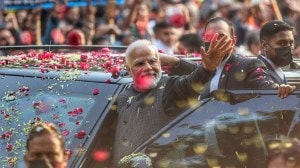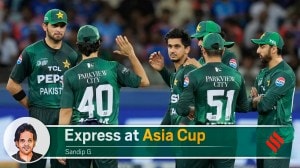Master of Spice
Coolie, of course, made at the time of the looming threat from video, was not merely a film but ‘‘an important media event’&#...

Connie Haham, an American teacher in Paris, discovered Hindi cinema fortuitously, in a local cinema in Paris, in 1979. The first Hindi film she saw was Amar Akbar Anthony. ‘‘I had not the slightest idea what was happening in the story,’’ she writes. ‘‘The characters were many and confusing. I thought the one called Salma was several different women because in one scene she was singing and dancing, in another scene, working as a doctor, in another, being chased around the house by her tyrannical father, in another, wearing a black robe and veil, in another, working as a seamstress with her husband.’’
But of course. What would Hindi movies do without the Salmas of the world?
Haham stayed on to see more Indian cinema, and grew to love it. This study, eminently readable, focuses on two films, Amar Akbar Anthony and Coolie, in some detail, while the second part of the book dwells on themes and technical aspects.
Amar Akbar Anthony, on her first viewing, seemed ‘‘a mixture of Shakespearean comedy with unlikely chance meetings and situational turnarounds, of Elvis Presley fight-sing-and-dance films, of Yiddish stories with touching mother-son scenes, of cowboy or gangster bad-guy sequences, of Tarzan-style role swinging to save those in danger, and of a Three-Musketeers spirit of camaraderie…”
But then, that was never the point, was it? And Haham recognises that, approaching Desai’s unique masala genre with openness and humour. She describes the enduring legacy of Manmohan Desai’s films: such as in Khalid Mohammed’s Fiza, which showed the living streets of Bombay, the coastline and the beautiful Haji Ali shrine (where the final fight scene of Coolie was played out). The sheer energy of Desai’s films, their inventiveness, their spirited music.
His biggest legacy, of course, was that from black and white days in 1960 to colour from 1968 to 1988, he provided rollicking, popcorn, mirch-masala entertainment. Films about brothers and families (after all, one of his early films was Raampur ka Lakshman; another was Bhai Ho to Aisa), life-and-death friendships, good guys and bad guys, lots of romance, and lots of song and dance. The kind of films that should be watched in large groups, sitting in the back stalls, whistling and stomping your feet.
And that’s the legacy that leads Haham to encounter, years later and quite unexpectedly on a Paris street, a drunken man weaving down the sidewalk, singing a song from Dharam Veer: ‘‘Main galiyon ka raja, tum mahalon ki rani’’. As she points out, the inhabitants of Paris rarely sing. But ‘‘years later and far from his Bombay home, Manmohan Desai, who had also known both sadness and joy, was still pleasing a member of his public.’’
Enchantment of the Mind is a warm tribute, laced with humour and affection, to a film-maker who loved to entertain.
Photos


- 01
- 02
- 03
- 04
- 05





























